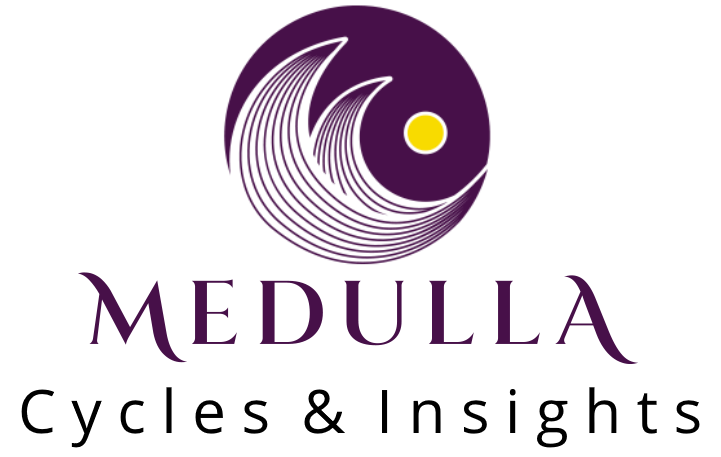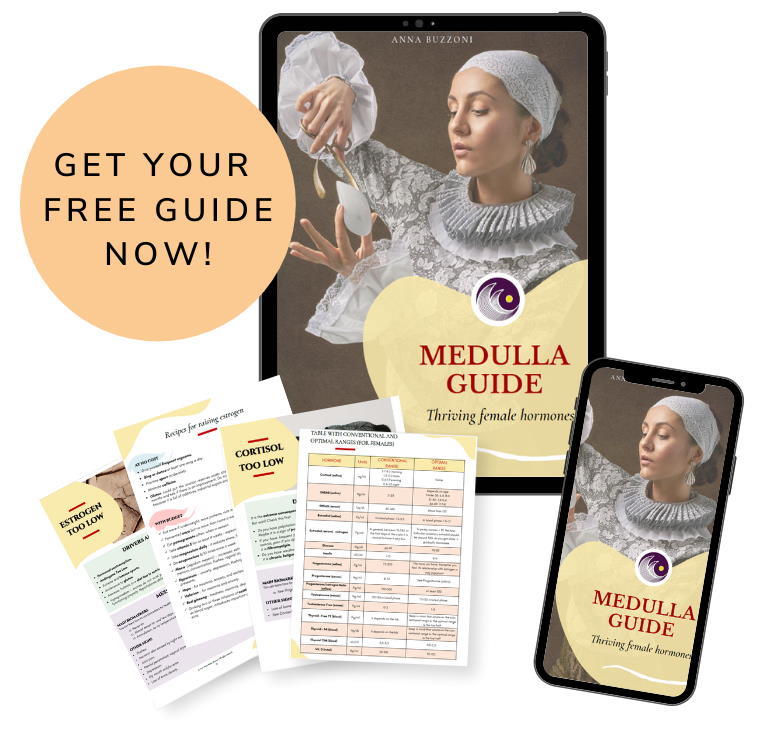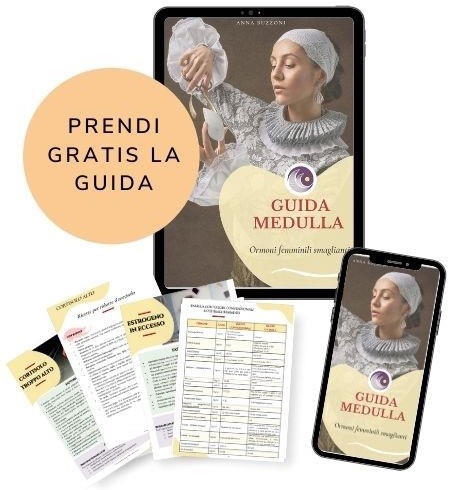The rhythm, the vibration, is the basic pattern of life. Understanding the measure of things means moving in harmony with life. It seems difficult, sometimes impossible, and our efforts seem to clash against energies outside of our understanding and possibility. But as women we have at our disposal an innate cog that can teach us to recognize the melody of rhythm: the menstrual cycle. The word “menstrual” comes from the ancient meaning “being able to measure Time, reality”, like medicine, mind, man, meditation.
Some characteristics of the menstrual cycle
The menstrual cycle is divided into two pivotal phases and two dynamic phases characterized by complementary and opposite energies:
- Menstruation – pivot, nadir. Something dies (endometrium) and something is born (new follicles are fed again). Basal phase of the uterus, which resets and purifies, and balance between estrogen and progesterone, the two female hormones, at their lowest intersection point, the nadir.
- Follicular – augmentative, centripetal, extrovert dynamics. The follicles grow and so does the endometrium (the inner lining of the uterus), which “wakes up” and begins to grow. Estrogen dominates and stimulates the left hemisphere, thus favouring study, logic, verbal expression, attention, planning, ambition, assertiveness, sociability (and more); sugar is assimilated more quickly by the brain. It is scientifically proven that at this stage it is easier to undertake new projects.
- Ovulation – pivot, zenith. Something dies (the follicle) and something is born (egg and corpus luteum). The uterus reaches its maximum point of expansion. We have a peak of serotonin, dopamine and testosterone: sociability, empathy, libido, courage, love of risk, determination and enthusiasm. Estrogen and progesterone are in balance, at their highest intersection point, the zenith. It is scientifically proven that during ovulation it is easier to get what you want.
- Luteal – centrifugal, excretory and introspective dynamics. The uterus loses turgidity and becomes more porous, moreover, it is now able to nourish. The progesterone dominates, stimulating the right hemisphere: our capacity of judgment is accentuated, because introspection is stimulated and therefore we are able to see beyond and “take the right measure” of things. For example, one is able to better interpret the intonations of other people’s voice and body language, and one is in contact with one’s own feelings. The progesterone makes us sensitive, both emotionally and physically, i.e. able to discern. It is scientifically proven that in this phase it is easier to eliminate harmful habits.
This partial scheme helps us to analyze other cycles, of which the menstrual cycle is the mirror. Today we look more closely at its similarities with breathing, the moon, plant sap, the seasons and the circadian rhythm, i.e. the innate internal clock, set to 24 hours.
Breath
Like the cycle, it is divided into two pivotal and two dynamic phases, and reflects its action on the body, mind and psyche.
- Empty lungs pause – pivot, nadir. The lungs are empty; in oriental breathing practices it is the stage of awareness.
- Inhalation – augmentative dynamic, centripetal, extroverted. It brings nourishment and energy to muscles, organs such as the brain, and the psyche (think of the inspirations we take to gain courage, inspiration and strength).
- Pause after inhalation – pivot, zenith. The lungs are full; in Eastern disciplines, it is the phase in which the intention materializes. The conception of intention.
- Exhalation – centrifugal, excretory and introspective dynamics. It eliminates negative metabolites from the body, and is the phase in which physical effort is made; it is the phase of sorting, calm, maximum effort and grounding.
Moon and plant sap
Leaving aside in this post the etymology of the words (which you can read on our FB page of December 5, 2016) the rhythm of the lunar cycle lasts 29.5 days, as the average menstrual cycle, considered normal between 23 and 35 days once stabilized and before entering the perimenopause – and governs the dynamics of plant sap:
- new moon / hinge / sap is concentrated in the roots
- crescent moon / ascending dynamics / the sap rises to the sky
- full moon / hinge / sap concentrates in the tops
- moon descending / dynamic descending / sap descending towards the earth
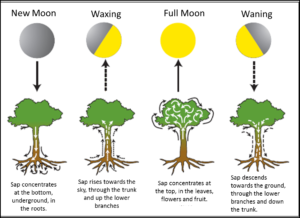
Image taken from the book “La Luna” by J. Restrepo, engineer agronomist and teacher
Seasons
- winter / pivot: solstice, plants rest and regenerate. Death is only apparent.
- spring / growth dynamics: light grows; plants germinate.
- summer / pivot: solstice, plants ripen.
- autumn / excretory dynamic: plants begin to strip themselves of the superfluous, i.e. they let go what must live, like seeds, and what must die, like leaves.
Circadian rhythm
If we split it four ways, we’ll see that:
00:00 to 6:00 – we have the nadir of body temperature (as in the menstrual cycle), and deep sleep, with its regenerative functions of body, mind and emotions. It is the reset of body and mind.
6:00 – 12:00 – we have the peak of attention and testosterone, from which we synthesize estrogen in a very poetic way that we will tell ourselves another time.
12:00 – 18:00 – we have the peak of motor coordination and cardiovascular capacity. In the menstrual cycle, there is a peak of serotonin, and the zenith between estrogen and progesterone makes us give our best in group work and to help others without losing energy.
18:00 – 24:00 we have the peak body temperature, while melatonin production starts again. In the menstrual cycle, body temperature rises and stays that way until the new cycle. Moreover, progesterone stimulates sleep, calm and introspection (it is not in contradiction with the pre-menstrual syndrome, but we will see why at another time, in a dedicated post).
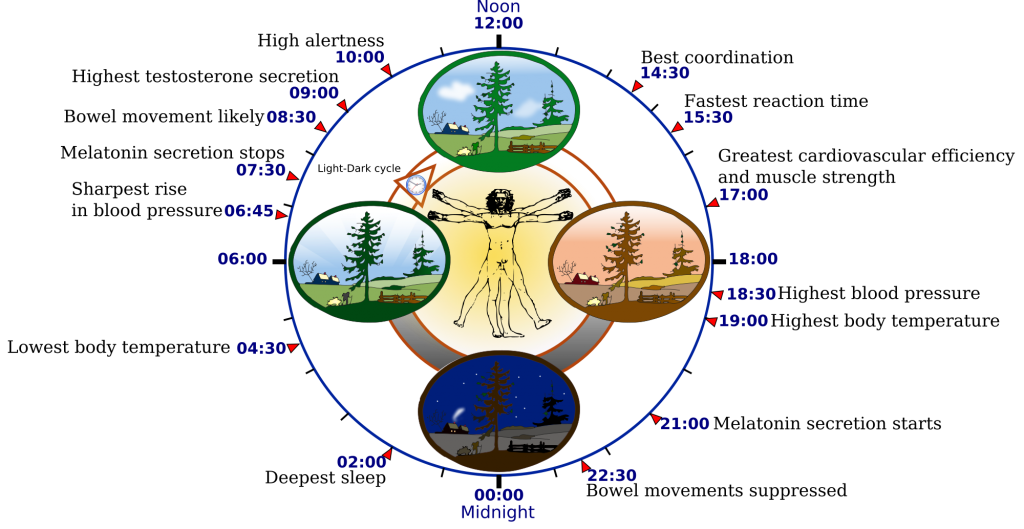
Image taken from Wikicommons
As we have seen, the menstrual cycle expresses an order intrinsic to life on Earth, and perhaps the Universe itself.
The correspondences of the natural world with the menstrual cycle do not stop here. We will also talk about the physiological parameters observable by the naked eye, and we will see how the characteristics of the four phases are observable on the body (we have only mentioned here the body temperature in the luteal phase, but we will also see how the fluids and the cervix change in each phase, in a coherent way).
We could also talk about the mirror in culture, in management, in the processes of creativity, such as design-thinking, archetypes, fairy tales, mythology, psychoanalysis, among others…
…always reminding us that science is transmissible, but knowledge is not: knowledge is the result of an individual cognitive act, it is the result of experience, and as such it is not withdrawable and transferable to others. If you want to “know” the rhythm of the cycle, you can learn to recognize it by keeping a daily diary of the necessary parameters or by working with Anna on the energies of the cycle, which teaches us, month after month, when, how and what to feed ourselves, when, how and what to eliminate, and how to regenerate ourselves.
This article was originally published in 2016
